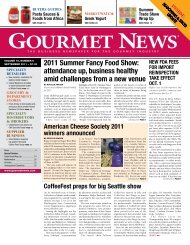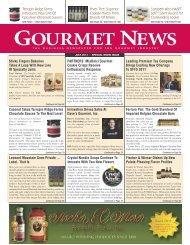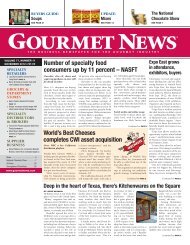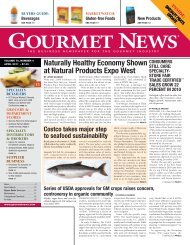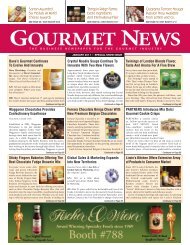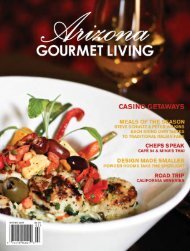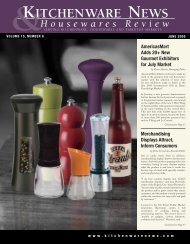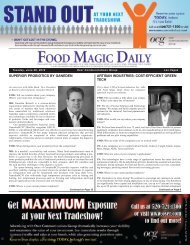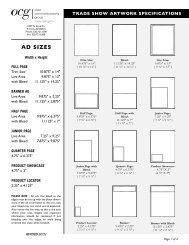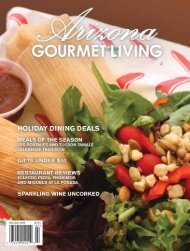June 2012 - Oser Communications Group
June 2012 - Oser Communications Group
June 2012 - Oser Communications Group
You also want an ePaper? Increase the reach of your titles
YUMPU automatically turns print PDFs into web optimized ePapers that Google loves.
26<br />
CHEESE<br />
GOURMET NEWS JUNE <strong>2012</strong> www.gourmetnews.com<br />
Specialty cheese sees<br />
another strong year<br />
Cheese remained the top category in specialty<br />
food spending this year, with $3.44<br />
billion in sales in 2011 (NASFT figures).<br />
Whether eating on cheese plates or incorporating<br />
it into dishes, consumers are taking<br />
well to specialty cheese and making<br />
room for it in their plates and budgets. Experienced<br />
cheesemongers are in demand,<br />
and consumer interest in and familiarity<br />
with artisan cheese—especially from<br />
America—is high and growing.<br />
Here are some suggestions for how retailers<br />
can take advantage of it.<br />
Highlight local interest.<br />
Make the store a takeoff point for cheese<br />
appreciation and pairing classes, visits to<br />
cheese festivals and farm tours. Invite<br />
local cheesemakers and producers of accompaniments<br />
like spirits, charcuterie and<br />
pickles for “Meet the Producer” days or<br />
themed dinners. This becomes more relevant<br />
as the concept of *terroir* becomes<br />
more applicable to certain cheeses.<br />
Make it fun and approachable.<br />
Dressed up versions of grilled cheese,<br />
mac-and-cheese and cheeseburgers<br />
seem to be customers’ favorite gateways<br />
to artisan cheese, as these items continue<br />
to be popular despite years of overexposure.<br />
Norseland, for example, is promoting<br />
“Jarlsbergers” for summer.<br />
Atlanta retailer Star Provisions makes it<br />
easy for customers to experience new regional<br />
cheeses with a monthly “Cheese<br />
and Crackers” club highlighting producers<br />
from the Southern United States.<br />
Unusual promotions make a difference.<br />
A good example is Jana Foods’ Dutch bicycle<br />
draw, which capitalizes on cycling’s<br />
Europhile appeal and provides retailers<br />
with eye-catching displays and materials<br />
to promote the brand’s authentic, awardwinning<br />
Dutch cheeses.<br />
Beyond the cheese shop<br />
The last year has seen moves by two<br />
iconic cheese companies, Artisanal and<br />
Murray’s Cheese, to reach new areas of<br />
the country. Artisanal tied up with megadistributor<br />
KeHe—which has a strong network<br />
of wine stores as well—last year, and<br />
the partnership has only grown.<br />
Built around Artisan’s very popular<br />
Cheese Clock, the partnership incorporates<br />
retailer support and professionallymanaged<br />
consumer social marketing. One<br />
of the new aspects is color-coded tags for<br />
wine bottles that match sections on the<br />
Cheese Clock, allowing foolproof selection<br />
by busy shoppers. The company<br />
has run promotions with retailers,<br />
including Costco, HEB, Schnucks,<br />
Specs, Winestyles and Whole Foods<br />
Market, and many more are projected<br />
for <strong>2012</strong>.<br />
Through a partnership with Kroger<br />
that began in 2009, Murray’s is now in<br />
nine states. The mini-stores typically<br />
carry more than 150 types of cheese<br />
and accompaniments, bringing a slice<br />
of the selection and expertise of the<br />
iconic New York City store to much<br />
wider availability. A Portland store with<br />
about 300 varieties of cheese opens in<br />
Fred Meyer in <strong>June</strong>.<br />
In other unusual placements, shoppers<br />
at prototype upscale Walgreens (State and<br />
Randolph in Chicago, the historic building<br />
Duane Reade on Wall Street, and one set<br />
to open in Boston) can now purchase<br />
cheeses from labels like Sartori along with<br />
wine, eyebrow shaping, international<br />
newspapers and takeout sushi.<br />
Issues<br />
As appreciation for raw milk cheeses<br />
grows, so does the debate. The American<br />
Cheese Society continues to dialogue with<br />
the FDA and other agencies, toward updating<br />
regulations to consider small dairies<br />
and cheese producers. Sessions on raw<br />
milk and communicating during a food<br />
service crisis are part of the ACS conference<br />
this year. Imports are another area of<br />
concern, as prolonged inspection procedures<br />
create a challenge for highly perishable<br />
fresh cheeses.<br />
Looking ahead<br />
This year’s ACS Conference will also see<br />
the first-ever Certified Cheese Professional<br />
exam, an important step in professionalizing<br />
cheese expertise.<br />
Goat cheese may have been a late arrival<br />
to the U.S. market, but based on the ACS<br />
Cheesemaker survey released earlier this<br />
year, it is definitely catching up. While 64 percent<br />
of surveyed cheesemakers use cow’s<br />
milk, goat cheese is a close second at 51<br />
percent. Goats are more affordable to raise<br />
than cows, and this may accelerate even further<br />
as the market for goat meat develops.<br />
Interest is also growing in sheep’s milk<br />
(used by 15 percent of surveyed cheesemakers),<br />
both for cheese and thick Eurostyle<br />
yogurt, though the supply is limited.<br />
Greek and Greek-style cheeses beyond<br />
feta are starting to surface, buoyed by the<br />
interest in Greek yogurt, and the continued<br />
expansion of the Hispanic market and upscale<br />
Latin American cuisines shows promise<br />
for higher quality Mexican cheeses.




